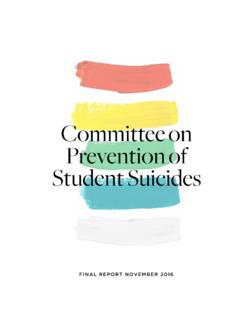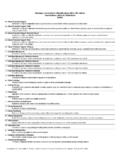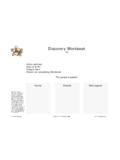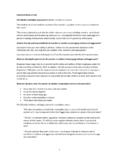Transcription of BEHAVIOURAL SUPPORT PLAN REFERENCE GUIDE …
1 BEHAVIOURAL SUPPORT plan . REFERENCE GUIDE . For ADULT DEVELOPMENTAL SERVICES. To be used in accordance with the requirements outlined in Ontario Regulation 299/10 Quality Assurance Measures (QAM) and the Policy Directives for Service Agencies made under the authority of Services and Supports to Promote the Social Inclusion of Persons with Developmental Disabilities Act, 2008 (SIPDDA). February 2017. Table of Contents Foreword 3. Legend 5. Definitions 6. Behaviour SUPPORT plan 6. Challenging Behaviour 6. Intrusive Behaviour Intervention 6. Positive Behaviour Intervention 7. Requirements 8. Behaviour SUPPORT plan 8. Intrusive Behaviour Intervention 10. Training 15. Third Party Review Committee 17. 2. Foreword The Services and Supports to Promote the Social Inclusion of Persons with Developmental Disabilities Act, 2008 (SIPDDA), guides the transformation of developmental services with a focus on progressive, community-based living that puts inclusion at the forefront.
2 The SIPDDA. legislation sets out standards under Ontario Regulation 299/10 known as Quality Assurance Measures (QAM). QAM standards help ensure agencies and Developmental Services Ontario provide high quality services and supports to their clients. Policy directives issued by the Ministry of community and Social Services (MCSS) help interpret the QAM standards. All developmental service (DS) agencies funded by MCSS were required to comply with these as follows: As of January 1, 2011, all 280 quality assurance measures. As of June 1, 2012, all requirements outlined in the Policy Directive for Service Agencies. Purpose of this GUIDE This GUIDE provides information to help clarify the requirements on behaviour SUPPORT plans as outlined in QAM, Part III, Behaviour Intervention Strategies, and Policy Directive : SUPPORT People with Challenging Behaviour Under these requirements, service agencies must develop an individual behaviour SUPPORT plan for every client with a developmental disability who has challenging behavior.
3 3. These requirements only apply to service agencies that provide any of the following types of services and supports: 1. Supported group living residences. 2. Intensive SUPPORT residences. 3. Community participation services and supports. 4. Activities of daily living services and supports. 5. Caregiver respite services and supports. SIPDDA, QAM and the policy directives are the source documents used in writing this REFERENCE GUIDE . 4. Legend Requirements related to behaviour SUPPORT plans that include intrusive measures have the word intrusive bolded and underlined. This text is policy interpretation and/or additional information to help clarify the requirements of QAM and the Policy Directive for Service Agencies. 5. Definitions Behaviour SUPPORT plan Intrusive Behaviour Intervention means a document that is based on a written means a procedure or action taken on a functional assessment of the person that person in order to address the person with considers historical and current, biological a developmental disability's challenging and medical, psychological, social and behaviour, when the person is at risk of harming environmental factors (a bio-psycho-social themself or others or causing property damage.)
4 Model) of the person with a developmental (QAM, (2) definitions). disability that outlines intervention strategies For purposes of the definition of intrusive designed to focus on the development of behaviour intervention , the following are positive behaviour, communication and examples of intrusive procedures or actions: adaptive skills. (QAM, (2) definitions) 1. Physical restraint The written functional assessment refers 2. Mechanical restraint to a detailed analysis of the behaviour 3. Secure isolation or confinement time out in relative to its contingencies and as a a designated, secure space. best practice should be based on direct 4. Prescribed medication to assist the person observation and data. in calming themself, with a clearly defined protocol developed by a physician as to Challenging Behaviour when to administer the medication and means behaviour that is aggressive or injurious how it is to be monitored and reviewed to self or to others or that causes property (QAM, (4)).
5 Damage or both and that limits the ability of the person with a developmental disability to participate in daily life activities and in the community or to learn new skills or that is any combination of them. (QAM, (2) definitions). 6. The ministry established the Expert Positive Behaviour Intervention Panel on Behaviour Intervention means the use of non-intrusive behaviour Safeguards to give advice and make intervention strategies for the purpose of recommendations on permissive and reinforcing positive behaviour and creating non-permissive BEHAVIOURAL management a supportive environment, with a goal of standards in SUPPORT of quality services changing the behaviour of the person with and SIPDDA. a developmental disability. The following are examples of non-intrusive behaviour M. embers of the Expert Panel included intervention strategies: representatives from developmental services agencies, professionals with 1.
6 Teaching or learning components, expertise in mental health (and dual including teaching proactive skills and diagnosis), psychology, behaviour communication strategies to maximize therapy, a representative from a the person's abilities and to minimize community advocacy group, and challenging behaviour. representatives from MCSS. 2. Reinforcement. T he Expert Panel helped inform 3. A review of the person's living environment, the development of the behaviour including the physical space, and SUPPORT intervention requirements in QAM. and social networks, to identify possible causes of challenging behaviour and making changes to the living environment to reduce or eliminate those causes. (QAM, (5)). 7. Requirements Behaviour SUPPORT plan The behaviour SUPPORT plan shall: Each service agency shall develop an individual O. utline positive behaviour intervention behaviour SUPPORT plan for each person with a strategies and, where applicable, intrusive developmental disability who has challenging behaviour intervention strategies, including behaviour.
7 (QAM, (1)). the least intrusive and most effective The behaviour SUPPORT plan shall be in addition strategies possible, for a person with to the person's individual SUPPORT plan (QAM, a developmental disability who has (3)) challenging behaviour. (QAM, s. 15 (3)1). Ensure that the behaviour intervention Q. AM and the Policy Directives for strategies are designed to focus on Service Agencies do not specify who the development of positive behaviour, must develop a behaviour SUPPORT plan . communication and adaptive skills to Q. AM does, however, require that enable the person to reduce, change and behaviour SUPPORT plans that include overcome their challenging behaviour that intrusive behaviour intervention limits their potential for inclusion in the strategies be approved community. (QAM, s. 15 (3)2). by a psychologist, a psychological associate, a physician, a psychiatrist or a behaviour analyst certified by the Behaviour Analyst Certification Board.
8 (QAM, s. 18(3)(e)). 8. The service agency shall ensure that the The behaviour SUPPORT plan is developed behaviour SUPPORT plan : with the involvement of the person with a) addresses the challenging behaviour a developmental disability who has identified in the BEHAVIOURAL assessment of challenging behaviour and/or, where the person with a developmental disability. applicable, persons acting on behalf of (QAM, (3)(a)) the person with a developmental disability, and the plan documents their involvement. b) c onsiders the risks and benefits of the (Directive, ). various interventions that can be used to address the behaviour. (QAM, (3)(b)) The person with a developmental disability c) sets out the least intrusive and most effective who has challenging behaviour and/or, strategies possible. (QAM, (3)(c)) where applicable, persons acting on d) i s monitored for its effectiveness.
9 Behalf of the person with a developmental (QAM, (3)(d)) disability, provides consent to the behaviour SUPPORT plan and the strategies that it e) is approved by a psychologist, a outlines. (Directive, ). psychological associate, a physician, a psychiatrist or behaviour analyst The clinician(s) who approved the plan certified by the Behaviour Analyst includes provision for the eventual fading Certification Board, where the behaviour or elimination of intrusive behaviour SUPPORT plan includes intrusive behaviour intervention strategies, which may be intervention strategies. (QAM, (3)(e)) outlined in the behaviour SUPPORT plan . f) i s reviewed at least twice in each (Directive, ). 12-month period. (QAM, (3)(f)). The positive behaviour interventions and Although QAM does not explicitly state intrusive behaviour interventions are used who must be involved in the twice annual as outlined in the behaviour SUPPORT plan of review, as a best practice, it is suggested the person with a developmental disability.
10 That when a plan includes intrusive (QAM, (2)). behaviour intervention strategies, the approver of the behaviour SUPPORT plan be involved in the twice annual review o the plan . 9. Intrusive Behaviour Intervention Monitoring during the use of intrusive behaviour intervention A service agency must ensure that intrusive behaviour intervention is A service agency shall ensure that there are used solely when the person with a protocols in place that must be followed in developmental disability is at immediate risk monitoring and assessing the condition of of harming themself or others or causing the person with a developmental disability property damage. (QAM, (1)) during the use of intrusive behaviour intervention. These protocols may differ, A service agency must ensure that a depending on the type of intrusive physical or mechanical restraint is carried intervention, and on the individual and his/.






